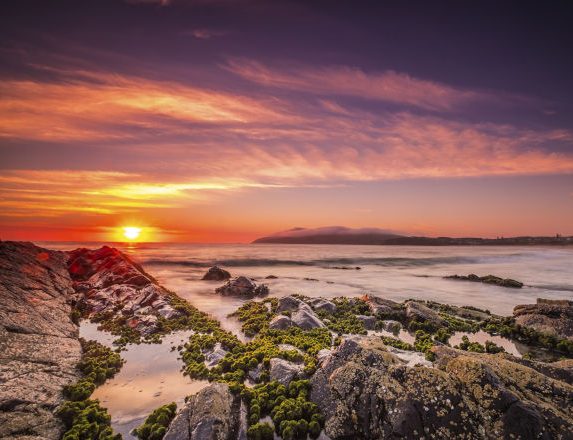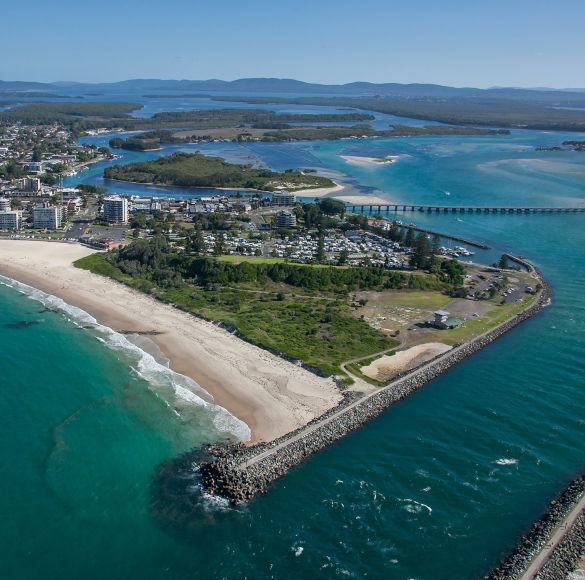The impressively scenic ‘double’ town of Forster-Tuncurry lies some three hours north of Sydney in the fabled Great Lakes region, where the tourism spin doctors tell us the magnificent eastern dividing range forms a backdrop to one of the most dazzling stretches of coast you will ever see.
Actually, they are just about spot on. The town itself, which boasts a population of some 15,000, lies on both sides of Wallis Lake and is connected by a long and modern bridge. This is a popular holiday resort and it is surrounded by water so, if bobbing boats and waterfront eateries are your thing, welcome to paradise!
It’s no wonder that most grey nomads heading up or down the coast choose to turn off at either Buladelah going north or Taree going south to detour off the Pacific Highway and into Forster-Tuncurry.
OVERVIEW

The sun rises over the stunning One Mile Beach in Forster. PIC: Destination NSW
The townsite of Forster, which was then known as Minimbah, was first surveyed in 1869 and renamed in 1870 after William Forster – the then secretary of lands. Across the river, Tuncurry was known as North Forster up until 1875. Although a ferry long operated between the two settlements, it was not until 1959 when the bridge between the two was built that the twin township of Forster-Tuncurry was truly born.
It is surrounded by national parks and the area features majestic headlands and long secluded beaches. As you might expect there are excellent facilities for water sports and fishing here and the beaches, of which there are at least a dozen nearby, are truly spectacular. All in all, it’s a great place to cool your wheels and pamper yourself before venturing up or down the highway again.
Unsurprisingly, with so many long distance paths and pleasant coastal tracks around, walking is another favourite pastime for visitors. Although it is well serviced with everything from supermarkets and mechanics to hairdressers and cinemas, there is still a relaxed atmosphere in this growing town. Perhaps, being just that little bit off the highway is the reason for its special ambience. After all, pretty much everyone who is here is here because they chose to be!

An aerial view of Forster Beach and Coolongolook River. PIC: Destination NSW
There are a variety of markets selling locally grown produce as well as arts and crafts on most weekends. And there always seems to be something else happening as well, From a healthy array of fishing and surfing events to the nearby Curtis Collection of Vintage Cars and the annual and eagerly-anticipated Oyster Festival held each October, there’s never a dull moment in this magnificent part of the world.
IN THE AREA
Wallingat National Park, Booti Booti National Park and the near iconic Myall Lakes National Park are all very close by. Indeed, Myall Lakes is one of the most visited parks in the entire state, helped largely by the fact that it boasts one of the state’s largest coastal lake systems – a Ramsar Wetland of International Significance – and 40 kilometres of beaches and rolling sand dunes. If all of that isn’t enough, the park is also home to The Grandis, an incredible 76-metre high flooded gum. Mucho impressive.
MAKE SURE YOU …
Visit the open air Green Cathedral which is a consecrated venue constructed for public worship and private devotion in 1922; visit Sugarloaf Point Lighthouse at Seal Rocks … it is one of only two towers in Australia which have an external stairway and the views are extraordinary; climb the steep 440m path to the Cape Hawke Lookout … a raised viewing platform affords quite spectacular 360° views of Forster-Tuncurry; visit the equally spectacular Whoota Whoota lookout where you can see all the way to Port Stephens on a clear day; enjoy the much-loved Bicentennial Walk from Forster Main Beach to Bennetts head.
WHERE TO CAMP
There are a number of well-equipped caravan parks in the Forster-Tuncurry area and, while they tend to be family orientated, if you avoid the school holidays you will certainly have a relaxing stay. National park camping options are relatively numerous and uniformly attractive. The Yagon camping area just south-west of the magnificent village of Seal Rocks, the Violet Hill Camping area 20 kilometres east of Bulahdelah, and the Mungo Brush camping area 20 km north of Hawks nest are all popular with caravanners.